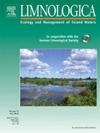高海拔安第斯山脉湖泊的的喀喀湖外普诺湾的水质和营养状况
IF 2
4区 环境科学与生态学
Q2 LIMNOLOGY
引用次数: 0
摘要
的的喀喀湖是世界上海拔最高的可通航淡水湖。它具有丰富的生物多样性,尽管各种人为活动正在损害它。因此,了解水质状况对于维持最佳的生态系统健康至关重要。本研究的目的是通过测量水质的理化参数、营养成分、重金属和浮游植物组成作为营养状态的代表来评价水质。在2016年至2018年、2020年和2021年期间,在外普诺湾的四个地点进行了14次采样。大部分理化参数均在适宜的环境质量范围内。浮游植物共由132个分类群组成,其中蓝藻门23个,绿藻门54个,绿藻门12个,硅藻门37个,海藻门5个,绿藻门1个。电导率在所有取样点均超过既定极限值。结果表明,该水质的理化性质处于最佳状态。硅藻多样性指数(H′)和总硅藻指数(IDG)显示,大部分样点的水体污染程度为中~中度,处于少营养化到中营养化状态。的的喀喀湖显示出污染状况,随着国家有关环境质量法规的实施,污染状况应该得到缓解。本文章由计算机程序翻译,如有差异,请以英文原文为准。
Water quality and trophic state in Outer Puno Bay, Lake Titicaca, a high-altitudinal Andean lake
Lake Titicaca is the world's highest navigable freshwater lake. It is rich in biodiversity, although a variety of anthropogenic activities is harming it. As a result, knowing the water quality state is critical for maintaining optimal ecosystem health. The objective of this study was to evaluate the water quality by measuring physicochemical parameters, nutrients, heavy metals, and phytoplankton composition as a proxy of trophic state. During the years 2016 to 2018, 2020 and 2021, 14 samplings were carried out at four sites within Outer Puno Bay. Most physicochemical parameters were within the appropriate ranges of environmental quality. Phytoplankton was made by a total of 132 taxa including 23 Cyanobacteria, 54 Chlorophyta, 12 Charophyta, 37 Bacillariophyta, 5 Miozoa and 1 Ochrophyta. The electrical Conductivity exceeded the established limit value at all sampling sites. The results indicated that the water’s physicochemical quality presents optimal conditions. The diversity indexes (H') and the General Diatom Index (IDG) revealed that most of the sampling sites exhibit waters with medium to moderate pollution and are in the oligotrophic to mesotrophic state. Lake Titicaca shows pollution conditions that should be mitigated with the implementation of the relevant national environmental quality regulations.
求助全文
通过发布文献求助,成功后即可免费获取论文全文。
去求助
来源期刊

Limnologica
环境科学-湖沼学
CiteScore
3.70
自引率
5.90%
发文量
64
审稿时长
3 months
期刊介绍:
Limnologica is a primary journal for limnologists, aquatic ecologists, freshwater biologists, restoration ecologists and ecotoxicologists working with freshwater habitats.
 求助内容:
求助内容: 应助结果提醒方式:
应助结果提醒方式:


